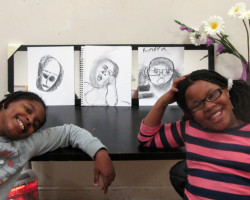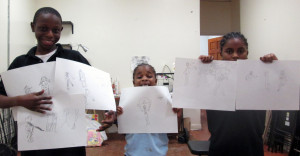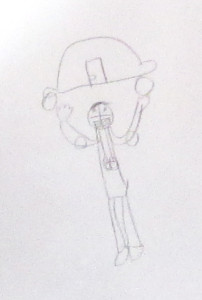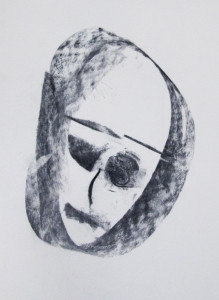The workshops at Window Studio have become an increasingly vibrant part of the project. Most of the kids who come are middle school age. While some, at least initially, are accompanied by a parent or another relative, several of them come completely on their own. A few, like Denari and his brother, live in one of the neighborhood shelters and haven’t come for awhile. Jerome who lives with his grandmother, frequently stops in on his way passed to check on my progress on various paintings. (“What, you’re still working on THAT one!”) It is quite amazing to me that a twelve year old should seize the opportunity to make art in this way. Full of curiosity about everything from the paint on my palette to who the people in the portraits are, they are particularly gratified when it proves to be someone they recognize from the neighborhood. (“Hey, that’s Ms. Carla with the little kids day care!”)
In addition to the discovery of seeing the people of the neighborhood transformed into paintings, the kids who come to the workshops find aspects of their own interests in a new context. For instance, they’ve been fascinated to discover that the action figures that the boys in particular love to draw from anime and graphic novels can be found in the drawings of the Renaissance masters like Raphael and daVinci. That the battles of superheroes and man have been the subject of art for hundreds, if not thousands of years is an exciting concept. Equally so is the realization that artists have figured out how to draw the human figure in these positions – flying, leaping, wrestling – partly from imagination, but also extrapolated from observation
So when Sam and Sirus, who continue to be regulars, recently brought a friend, Dejani, we decided to do a session of “action drawing”. It was a new take on one of the most traditional techniques of life-drawing class. They took turns with one of them posing while the others had 2 minutes to do quick sketches. Part of the fun was setting the stopwatches on their phones/watches, and then the “model” adopting as extreme a position as it was possible to hold for the 2 minutes without falling over. The model usually included instructions – “Make it look like flames are shooting from my fingers!” or “Make me lifting up a car!” — which the artists dutifully included!
We also looked for ways to capture the essence of the pose with a few directional lines rather than focusing immediately on details like the brand on a sweatshirt or style of sneakers. The pressure of the clock ticking added excitement. Sirus, who is six, is able to confidently draw his figure holding up a car, or emitting a force field with an economy of gesture. On the other hand, Dejani, who was new to art class, surprised himself by capturing the complex relationship of two overlapping figures by drawing exactly what he saw, and not so much what he thought he saw.
After the drawing sessions, we discuss what we like in each drawing. Surprising associations come up. In the case of Jeremy and Hanora’s portraits (top), we were all struck by the expressiveness of Hanora’s round mouth (“I look loud!”) or the way the soft smudgy middle portrait looked like a sleepy kid yawning in class. But we were all most interested by the intensity and texture of Jeremy’s first (lefthand) portrait. He said the person looked like a Muslim, or I said, someone wearing a hood, “like Trayvon Martin” he added. But it also looks like the way that sometimes the figure of death is represented in art, I explained. “Well that makes sense then,” Jeremy concluded.





The quick sketch is a wonderful tool for kids to loosen up and get away from the compulsion to detail and you have proved this successfully. The follow-up critique is a joy to read. The kids are truly learning to see AND feel their art. Great work-Ann & kids!
Thanks Mina! I look forward to hearing more about your experiences teaching art to kids too. The white board is one I will try, at least as a warm-up. Except that I also want them to value what they draw. Sometimes they just draw a line or two on a paper and then want to throw it away. Though I don’t want to inhibit them, I’ve also urged them not to give it up so quickly, to work past that initial frustration that hits me too after that first line doesn’t turn out exactly as I hoped. Most of art seems to be created out of that subsequent struggle to restore that first line to what you had in mind. You never can, but hopefully end up with something better than that initial conception. Hopefully!